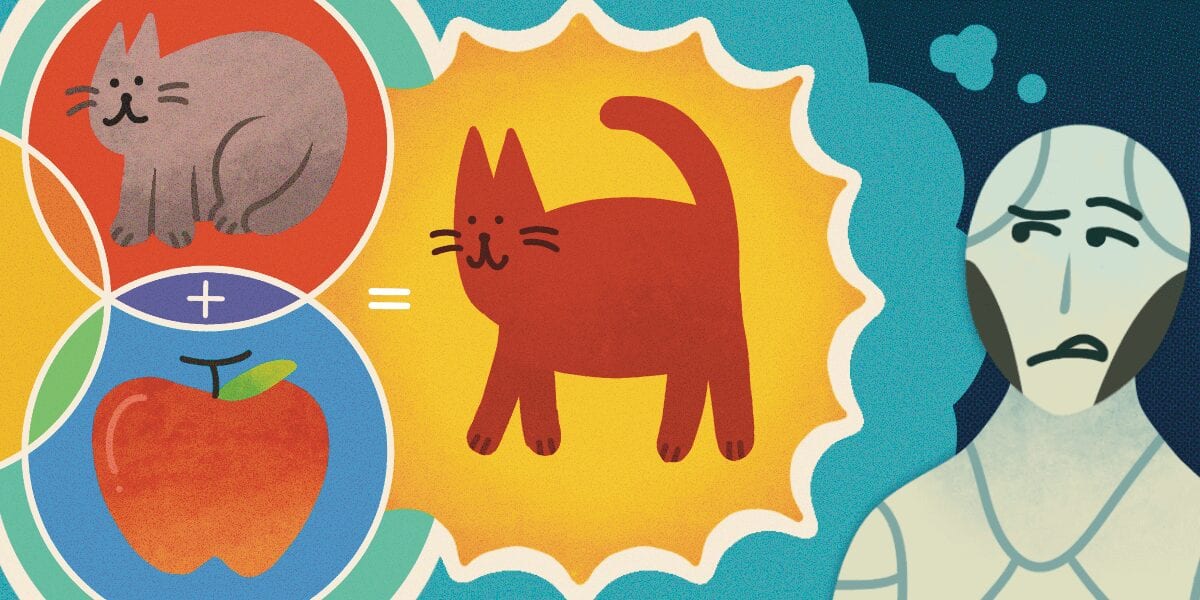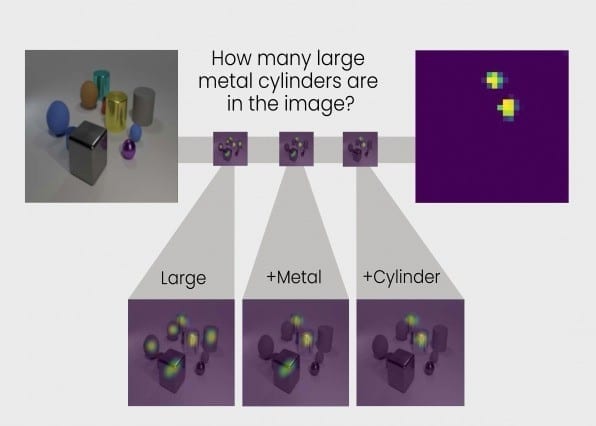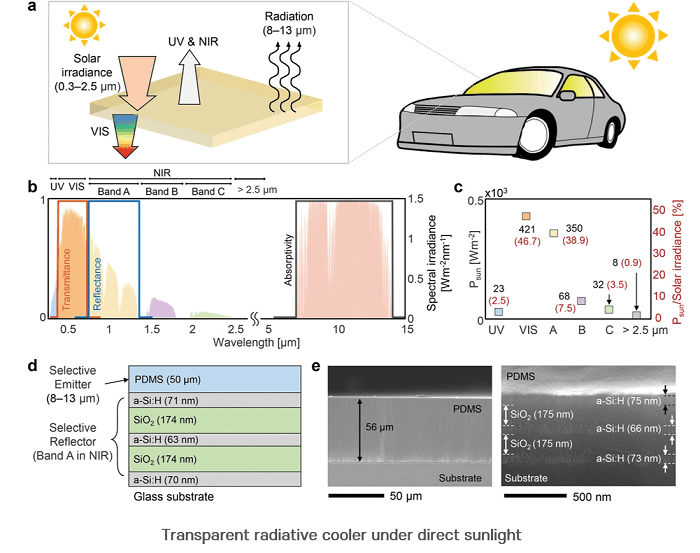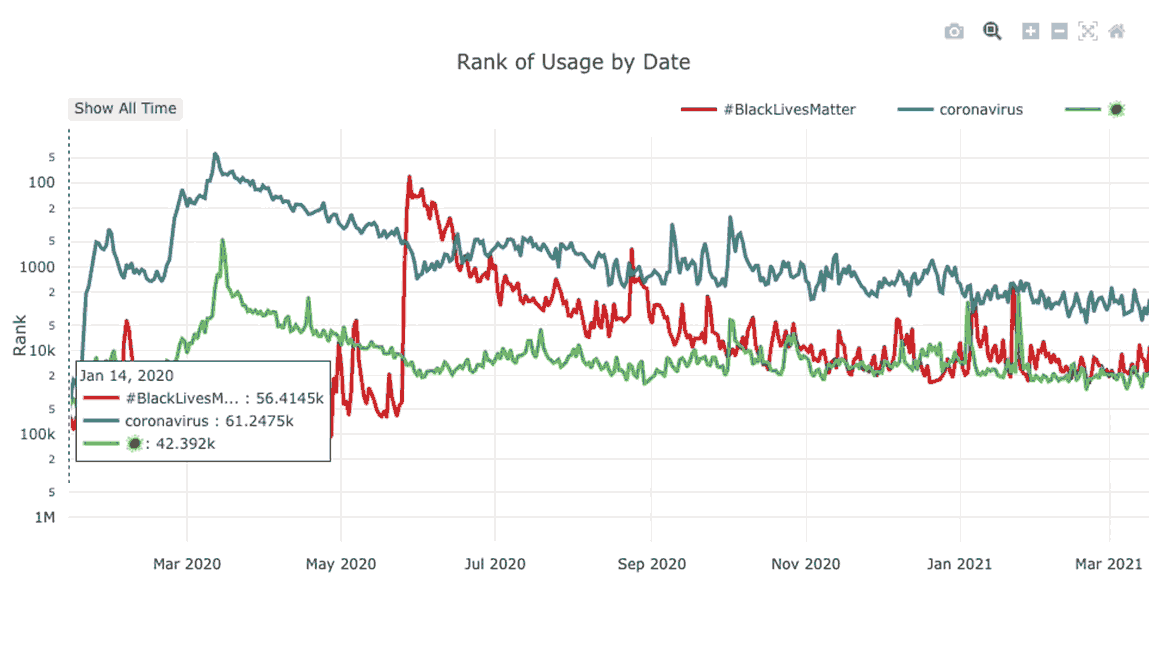
THE NEW AI SYSTEM TAKES ITS INSPIRATION FROM HUMANS: WHEN A HUMAN SEES A COLOR FROM ONE OBJECT, WE CAN EASILY APPLY IT TO ANY OTHER OBJECT BY SUBSTITUTING THE ORIGINAL COLOR WITH THE NEW ONE.
ILLUSTRATION/CHRIS KIM.
Imagine an orange cat. Now, imagine the same cat, but with coal-black fur. Now, imagine the cat strutting along the Great Wall of China. Doing this, a quick series of neuron activations in your brain will come up with variations of the picture presented, based on your previous knowledge of the world.
In other words, as humans, it’s easy to envision an object with different attributes. But, despite advances in deep neural networks that match or surpass human performance in certain tasks, computers still struggle with the very human skill of “imagination.”
Now, a USC research team comprising computer science Professor Laurent Itti, and PhD students Yunhao Ge, Sami Abu-El-Haija and Gan Xin, has developed an AI that uses human-like capabilities to imagine a never-before-seen object with different attributes. The paper, titled Zero-Shot Synthesis with Group-Supervised Learning, was published in the 2021 International Conference on Learning Representations on May 7.
“We were inspired by human visual generalization capabilities to try to simulate human imagination in machines,” said Ge, the study’s lead author.
“Humans can separate their learned knowledge by attributes—for instance, shape, pose, position, color—and then recombine them to imagine a new object. Our paper attempts to simulate this process using neural networks.”
“This new disentanglement approach, for the first time, truly unleashes a new sense of imagination in A.I. systems, bringing them closer to humans’ understanding of the world.”
Laurent Itti.
AI’s generalization problem
For instance, say you want to create an AI system that generates images of cars. Ideally, you would provide the algorithm with a few images of a car, and it would be able to generate many types of cars—from Porsches to Pontiacs to pick-up trucks—in any color, from multiple angles.
This is one of the long-sought goals of AI: creating models that can extrapolate. This means that, given a few examples, the model should be able to extract the underlying rules and apply them to a vast range of novel examples it hasn’t seen before. But machines are most commonly trained on sample features, pixels for instance, without taking into account the object’s attributes.
The science of imagination
In this new study, the researchers attempt to overcome this limitation using a concept called disentanglement. Disentanglement can be used to generate deepfakes, for instance, by disentangling human face movements and identity. By doing this, said Ge, “people can synthesize new images and videos that substitute the original person’s identity with another person, but keep the original movement.”
Similarly, the new approach takes a group of sample images—rather than one sample at a time as traditional algorithms have done—and mines the similarity between them to achieve something called “controllable disentangled representation learning.”
Then, it recombines this knowledge to achieve “controllable novel image synthesis,” or what you might call imagination. “For instance, take the Transformer movie as an example” said Ge, “It can take the shape of Megatron car, the color and pose of a yellow Bumblebee car, and the background of New York’s Times Square. The result will be a Bumblebee-colored Megatron car driving in Times Square, even if this sample was not witnessed during the training session.”
This is similar to how we as humans extrapolate: when a human sees a color from one object, we can easily apply it to any other object by substituting the original color with the new one. Using their technique, the group generated a new dataset containing 1.56 million images that could help future research in the field.
Understanding the world
While disentanglement is not a new idea, the researchers say their framework can be compatible with nearly any type of data or knowledge. This widens the opportunity for applications. For instance, disentangling race and gender-related knowledge to make fairer AI by removing sensitive attributes from the equation altogether.
In the field of medicine, it could help doctors and biologists discover more useful drugs by disentangling the medicine function from other properties, and then recombining them to synthesize new medicine. Imbuing machines with imagination could also help create safer AI by, for instance, allowing autonomous vehicles to imagine and avoid dangerous scenarios previously unseen during training.
“Deep learning has already demonstrated unsurpassed performance and promise in many domains, but all too often this has happened through shallow mimicry, and without a deeper understanding of the separate attributes that make each object unique,” said Itti. “This new disentanglement approach, for the first time, truly unleashes a new sense of imagination in A.I. systems, bringing them closer to humans’ understanding of the world.”
Original Article: USC researchers enable AI to use its “imagination.”
More from: University of Southern California Viterbi School of Engineering
The Latest Updates from Bing News & Google News
Go deeper with Bing News on:
Imagination in artificial intelligence systems
- How a Virtual Assistant Taught Me to Appreciate Busywork
A new category of apps promises to relieve parents of drudgery, with an assist from A.I. But a family’s grunt work is more human, and valuable, than it seems.
- What Happens When Killer Algorithms Outpace International Law
Careless use of artificial intelligence algorithms can have negative impacts on the human race beyond our imagination. Global regulations are still not in place for prevention of the negative effects ...
- Artificial Integrity
Artificial Intelligence may be the most evocative ... projections often stemming from science fiction imagination, these are just systems with advanced computational capabilities, rather than ...
- Imagination’s New Catapult CPU Is Driving RISC-V Device Adoption
Press Release Imagination Technologies today unveils the next product in the Catapult CPU IP range, the Imagination APXM-6200 CPU: a RISC-V application processor with compelling performance density, ...
- Artificial Intelligence: Long Island Businesses Are Not Buying It
Artificial intelligence may be the rage in the tech ... The results come at a time when AI has taken hold of the public imagination with its often stunning ability to conduct conversations with ...
Go deeper with Google Headlines on:
Imagination in artificial intelligence systems
[google_news title=”” keyword=”imagination in artificial intelligence systems” num_posts=”5″ blurb_length=”0″ show_thumb=”left”]
Go deeper with Bing News on:
Controllable disentangled representation learning
- EXER.4240 Motor Control & Learning
This course provides an in-depth presentation of the behavioral and neuroscientific foundations of human movement control, coordination, and the learning of movement skills. Topics include an ...
- Biden’s highest-ranking trans official is learning the limits of representation
It was rousing, but also an admission of the limits of her power: Levine, perhaps better than any other Biden official, shows what representation can and can’t do. “I look forward to a day in ...
- Control Systems and Reinforcement Learning
A high school student can create deep Q-learning code to control her robot, without any understanding of the meaning of 'deep' or 'Q', or why the code sometimes fails. This book is designed to explain ...
- Pollution and Environmental Control (online)
Our multidisciplinary online MSc in Pollution and Environmental Control aims to equip you with the quantitative ... Throughout the course, I was learning from and being supported by leading academics ...
- Graph Data Analytics and Representation Learning
No particular course is required as pre-requisite. The course requires basic knowledge of linear algebra, calculus, probability, (un)supervised learning, and programming experience in Python (used ...
Go deeper with Google Headlines on:
Controllable disentangled representation learning
[google_news title=”” keyword=”controllable disentangled representation learning” num_posts=”5″ blurb_length=”0″ show_thumb=”left”]










